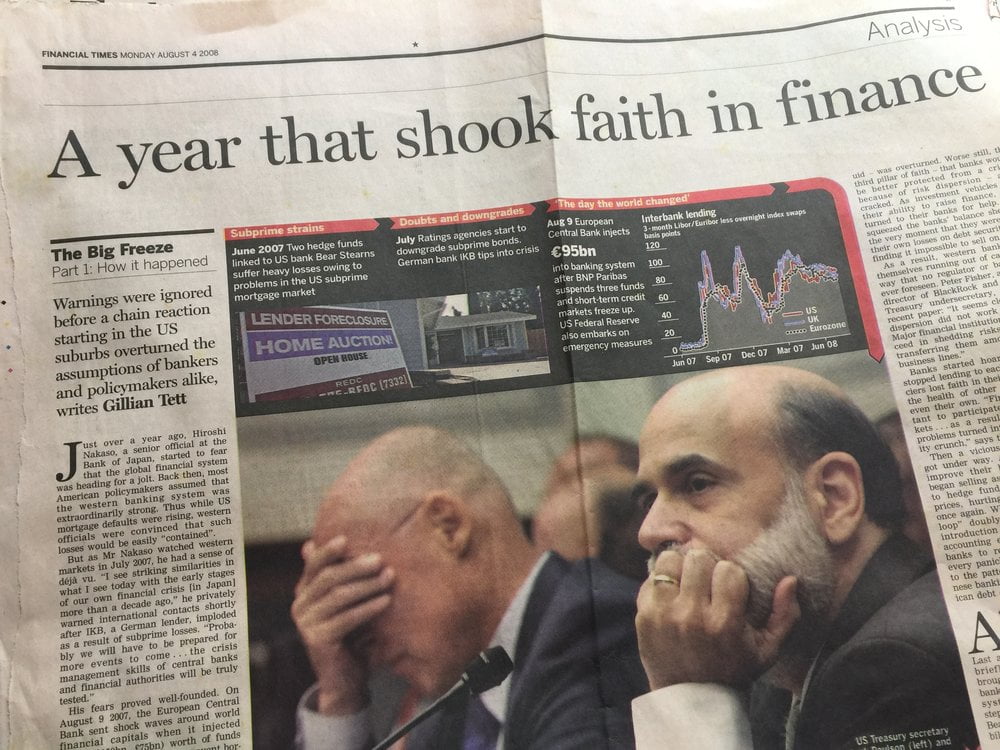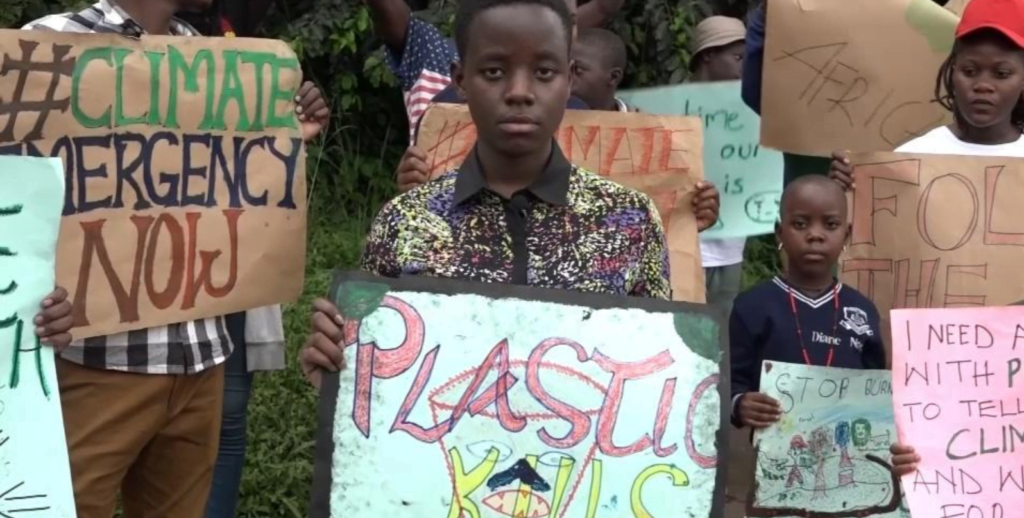PRIME (working with the New Weather Institute) organised an event at the TUC to commemorate the day – 9th August, 2007 – that inter-bank lending froze, central banks came to the rescue of private financial institutions, and the Global Financial Crisis began in earnest. We will be publishing transcripts and notes from that event, which was chaired by Ann Pettifor and included contributions by Frances Coppola, Professor Daniela Gabor and Andrew Simms of the New Weather Institute. In due course we will publish articles written before August, 2007 that warned of the forthcoming crisis.
To begin the series, we are posting a longer version of an article written by Ann Pettifor and published in Red Pepper on 08 August, 2017 – The economic crash, ten years on.
I know exactly where I was on 9th August, 2007. It was a Thursday. A hot summer’s day – ‘debtonation day’. Bankers all over the world had lost their collective nerve and refused to lend to each other, knowing their peers were probably insolvent. It was the day the globally synchronised financial system froze, and began its descent into sustained failure. Strangely it then took more than a year, and Lehman’s collapse, before the world as a whole understood the gravity of the crisis.
A year before, on 22nd May 2006, in a blog for the Guardian titled: The fall of the House of Finance, I had argued that
“the world is in a financial mess. Worse, Anglo-American economies could be heading for the kind of prolonged period of debt deflation that Japan is just emerging from: 15 years of economic pain, unemployment, family breakdown, social unrest and rising nationalism.”
Fast forward ten years, and that prediction is still playing out. The key feature of Britain’s post-crisis depression compared with its predecessors “is the frightening weakness of the recovery phase” to quote Martin Wolf of the FT. It has been a period of disinflation, noflation and deflation. In April 2015, the UK slipped into deflation when prices fell by 0.1% in the year to April.
While unemployment has fallen, and employment risen in the UK (not so in Europe) 55% of the jobs created since the crisis are part-time. There has also been a sharp rise in the self-employment rate which is up 700,000, but more self-employment doesn’t seem to be better. A typical self-employed person is paid less than a typical employed person. The self-employed are especially likely now to say they are underemployed. As the governor of the Bank of England noted on 19 January, 2016,
“In the wake of the crisis, one reason that headline unemployment has not been a sufficient summary statistic for slack in the labour market is because of underemployment of those in work.”
And as the TUC’s senior economist Geoff Tily has argued,
“output is well below potential because workers, while cheaper to employ, are not working to potential. More output could be produced, but not sold. There is an effective demand failure, high unemployment and, within companies, under‐utilisation of the employed workforce – a form of “labour hoarding”.
Led by George Osborne and Her Majesty’s Treasury, UK governments since 2010 have deliberately pursued policies of austerity, and for higher, if less secure employment. And by slashing national and local government investment, and by failing to stimulate private investment, our leaders have preferred to opt for lower productivity per worker.
The economic pain is reflected in the fall in real UK wages which are still 6% lower than at the start of the recession. In the East Midlands they’re down 10% since the crisis. London wages are down too, when London economic activity has been significantly stronger than other regions. And the incomes of the self-employed are down 22% since the start of the recession! Of the 34 developed nations that are members of the OECD, the only one that saw weaker wage growth than the UK between 2008 and 2015 was – wait for it – Greece! This is in part because the UK government has legislated for an extreme form of labour market ‘deregulation’ – which makes it easier for employers to make staff redundant, to downsize work, to casualize labour (e.g. zero hour contracts) and to cut wages.
This political and economic failure has caused great pain: to young people stuck in low-skilled and precarious jobs, and who do not believe they have a future; to those struggling on low incomes, and borrowing more to keep going. To young couples wanting, but failing to find a home in which to have children. To parents keen to send their children to university, but fearful of the debt burden that will befall them.
On a broader level, the overhang of both British and global private and public debt is now even vaster than before the crisis. Players in the world of global finance have created what Rizwan J. Mokal calls “gargantuan” financial markets. The eye-watering sums at stake include “the global market for over-the-counter derivatives, notionally worth $630 trillion, with about $21 trillion at risk excluding netting, or $3.4 trillion with netting. On-exchange futures worth $27.5 trillion and options totalling $41 trillion are outstanding.”
The Institute for International Finance – the global bankers’ club – reports that global debt rose by more than $11 trillion in the first nine months of 2016 to more than $217 trillion – 325% of GDP or global income. In 2007 global debt was 269% of global income. This overhang of debt continues to depress economic recovery, even while central banks keep interest rates low, and continue to pump about $200bn a month into the system. While the European Central Bank has cut its
Unpayable debts have not been acknowledged as unpayable and written off, and while some private debt in both the UK and US has been ‘foreclosed’ upon, private debts continue to depress economic activity, worldwide.
Try as they may, central bankers cannot revive the almost comatose global economy, despite each month pumping something like $200bn of liquidity or QE into global financial markets. This unprecedented scale of liquidity creation through the expansion of bond purchases by central banks has had virtually no effect on restoring full economic recovery in any of the economies in which QE is the main policy tool deployed (Japan, the US and the UK). Nor has QE proved inflationary – despite the efforts of central bankers and the alarmist fears of orthodox economists. Instead QE and other central bank operations have re-inflated the value of assets – owned by wealthy elites.
Simultaneously, in the real economy, investment, wages and salaries have fallen. Those who do not own and rent out income-earning assets like rental property, bonds (government debt), stocks and shares (that earn dividends) – have become poorer, and inequality has rocketed. In order to raise incomes many struggling individuals and families have joined the rentier economy by renting out their homes (Airbnb) or their own cars (Uber, Lyft). This is an extraordinary development, one in which workers invest in the ownership, maintenance and insurance of the capital asset (the home or car) – while the rentier class based in Silicon Valley, having invested in, borrowed or stolen open source software, systematically and almost effortlessly extract rent from the worker’s asset.
The truth is that we now live in a rentier economy – where the ‘takers’ effortlessly make capital gains by owning and renting out assets, or extracting rent from assets, while the ‘makers’ are left far behind. It is these developments that in my view have led to the dramatic rise in inequality worldwide.
The prediction made in 2006 of “rising nationalisms” is now a feature not just of emerging markets like India, Turkey and the Phillipines, but also of countries like the US, Russia, Hungary, and Poland. The British vote for Brexit was a nationalist impulse, in my view. But I underestimated the degree to which the fall, and subsequent publicly financed rescue of financialised globalisation would lead to the rise of authoritarians and kleptocrats. Ben Judah defines the post-crisis period as “the golden age of money laundering”.
“Globalisation’s deep, structural motors are in fact enabling authoritarians. Not only can capital now mask itself and disappear without any trace, but gigantic sums of money are now traveling the world in a concealed manner. Little by little, this has made the Western financial system hospitable to kleptocrats….The openness of the new century…is in fact rather well suited to the kleptocratic dictator – with a coterie of American lawyers, French bankers, German accountants and British public relations teams in tow.”
Nowhere is evidence of kleptocratic looting more tragic than in the scandal currently engulfing South Africa, where in a case of ‘state capture’ a family of billionaires have corrupted politics and looted South African assets.
So what is to be done?
Challenging and dismantling ‘gargantuan’ financial markets that operate beyond democratic regulatory oversight will not be easy. Some believe that the ‘genie is out of the bottle’ and management of financial markets by governments will never, ever be restored. I do not agree. The rise of fascism and the onset of wars could dismantle global financial markets in just the same way as World Wars I and II did.
There is a more peaceful way of transforming the global economy and restoring finance to the role of servants to, and not masters of economies and regions. But for that transformation to happen the public must begin to understand that citizens enjoy political power over global financial markets. We must learn to understand and exercise that power. For the global House of Finance is almost entirely dependent, and indeed largely parasitic, on the public sector. In other words, on taxpayers like you and me.
It is about time that we set terms and conditions for the largesse of our central bankers; for the low interest rates that allow big corporations and kleptocrats to leverage billions more; and for the government guarantees that ensured, and continue to ensure there are no runs on the banking system. And we need also to understand that the shadow banking system – home to the $630 trillion over-the-counter derivatives market, repos and other financial products – is almost entirely dependent for collateral – and for the re-use and re-hypothecation of collateral – on one precious asset: sovereign debt (bonds).
Quantitative Easing – the creation of liquidity directed only at the financial sector – is only possible because central banks, if not directly publicly owned, are nevertheless entirely dependent for their legitimacy and money-creation powers, on taxpayers. The Federal Reserve is ultimately backed by US taxpayers. The Bank of England is a nationalised bank, whose authority is derived from Britain’s 31 million plus, taxpayers. Even though the European Central Bank is deemed to be a ‘private’ central bank, independent of EU states, nevertheless every financier operating in global markets knows that the ECB is backed not only by Spanish, French and Italian taxpayers, but as importantly, by German taxpayers.
Citizens are clearly angry at the way in which the perpetrators of the financial crisis have been rewarded, and the poor and middle classes have been required to endure ‘austerity’. But taxpayers have largely watched passively as operators in capital markets milked central banks of liquidity in the form of QE; as financiers in the shadow banking sector used and abused public assets for leveraging ever-higher capital gains; as the owners of wealth borrowed money from central bankers at historically low rates of interest – in order to acquire more wealth.
Economists like Thomas Pikketty have railed against this inequality. But few economists have argued for ‘terms and conditions’ to be imposed on the global financial system, to end and constrain their reckless greed. Terms and conditions that would end inequality and restore balance to both economies and societies. And very few politicians have the courage to challenge the finance sector. Not Donald Trump (whose administration is now effectively governed by Wall St.). Not even Jeremy Corbyn or John McDonnell – who prefer to focus instead on taxation and government spending, or fiscal policy.
However, neither politicians or economists will make the case for holding the out-of-control finance sector to account, until citizens make that case. The people must lead, so that leaders can. Citizens must use the powers deployed by taxpayer-backed central banks and finance ministries to demand a transformation of the global financial system. If such demands are ignored, then we must campaign for the massive subsidies provided to the sector by our publicly-financed and taxpayer-backed institutions – to be withdrawn.
Nothing less will do.






